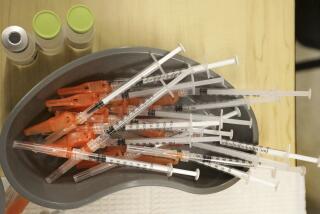We get enough vitamin D and calcium, panel finds
- Share via
A team of experts convened by the Institute of Medicine sought Tuesday to douse growing concerns that North Americans are deficient in two key nutrients — calcium and vitamin D — and that they risk higher rates of a wide range of chronic diseases and cancers as a result.
The panel concluded that “with few exceptions, all North Americans are receiving enough calcium and vitamin D” from the foods they eat — many of which have been fortified with both nutrients. For all but a few, adding more of those nutrients in pill form would be useless at best and, at worst, would risk harm, added the report, which was two years in the making.
The panel said its findings challenged the notion that, when it comes to dietary nutrients, “more is better” — a belief that has inspired a multibillion-dollar market for dietary supplements in the United States. Americans spent $1.2 billion last year on calcium supplements and $430 million on pills containing vitamin D, according to the Nutrition Business Journal.
Scouring more than a decade’s worth of new research, the 14-member Institute of Medicine panel found studies linking low blood levels of vitamin D with elevated rates of cardiovascular disease, metabolic disturbance and certain cancers to be “inconclusive and often contradictory.”
The panel warned that levels of vitamin D routinely sold in some dietary supplements could increase the risk of kidney and tissue damage and that extra calcium could boost the risk of developing kidney stones in people who take the pills regularly. It also cited “emerging evidence” that high levels of calcium may contribute to heart disease.
For most Americans, consuming 400 international units (IUs) of vitamin D daily is sufficient and 600 IUs are recommended, the panel said. People above the age of 70 should strive for 800 IUs, and no one should exceed 4,000 IUs. The previous guidelines, set in 1997, recommended a minimum of 200 IUs and a maximum of 2,000 IUs of vitamin D per day.
The panel’s conclusions drew protest from the growing community of activists promoting vitamin D supplementation and from the dietary-supplement industry’s principal trade group, the Council for Responsible Nutrition.
Andrew Shao, the trade group’s vice president for scientific and regulatory affairs, said the panel’s finding “lags behind a mountain of research demonstrating the need for vitamin D intake at levels possibly as high as 2,000 IUs per day for adults.”
Members of the panel acknowledged that their conclusions were a surprising reversal for two nutrients that had won growing followings. Studies — most looking at blood concentrations of these nutrients in large populations — have linked lower vitamin D levels to increased rates of cardiovascular disease, metabolic disturbances and type 2 diabetes, depression and certain cancers.
But the data suggesting benefits for higher levels of both nutrients were “far less consistent than I originally thought,” Dr. Steven K. Clinton, an Ohio State University oncologist and member of the Institute of Medicine panel, said at a news conference Tuesday. Clinton said he had expected that higher levels of vitamin D would prove beneficial in cancer prevention.
“It’s been a very enlightening process,” he said.
At the same time, the committee underscored the strength of evidence that adequate levels of both nutrients are important for maintaining the health of bones and preventing fractures. For a large proportion of adolescent girls, they warned, a deficit in calcium intake could have well-documented negative consequences later in life, when the risk of osteoporosis, falls and fractures increases.
The daily dose of calcium recommended by the panel varied according to age, with babies needing as little as 700 milligrams a day and adolescents requiring as much as 1,300 milligrams. Women over 50 and everyone over 70 should get 1,200 mg of calcium a day, the panel concluded. The mineral is abundant in dairy products as well as in fortified juices.
Vitamin D is found naturally in eggs and fatty fish such as salmon, and it has been added to an array of products including breakfast cereals, milk and juices. It also is produced and stored by the body in response to sun exposure. Spending as little as five to 15 minutes in the sun — without sunscreen — will produce much of one’s daily recommended dose.
Dr. Ishwarlal Jialal, a UC Davis endocrinologist whose research has linked low vitamin D levels to higher rates of pre-diabetes and diabetes, said the report issued Tuesday was “very fair” in its assessment that the evidence showing the vitamin can help with conditions other than bone health is only preliminary. But he said the panel’s message, which discourages daily doses of 2,000 IUs of vitamin D daily, seemed alarmist.
“I think they’re trying to scare people into not taking vitamins,” Jialal said. For people who have not had kidney stones, who are under a physician’s care and who are having their blood tested twice a year, a daily vitamin D supplement of 2,000 IUs “is reasonably safe” and may protect against worsening metabolic problems in some patients at risk for them, he said.
At the same time, Jialal added, some consumers may be taking 4,000 IUs daily without medical oversight. “There might be a lot of zealots out there,” he said.







